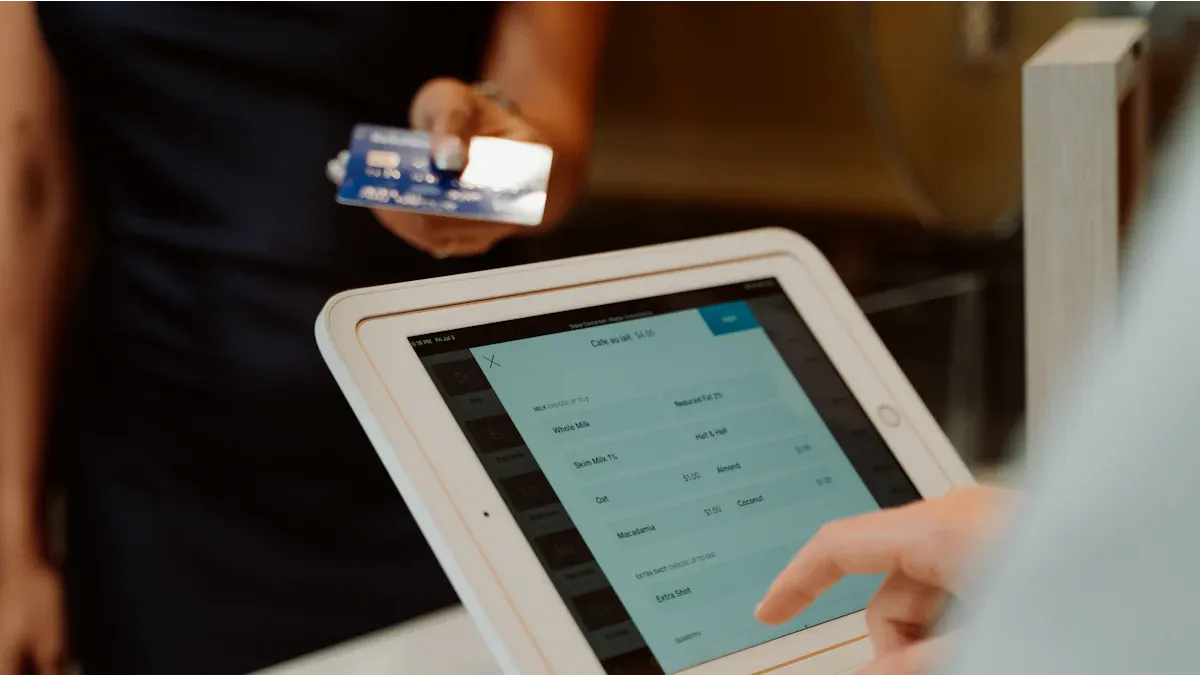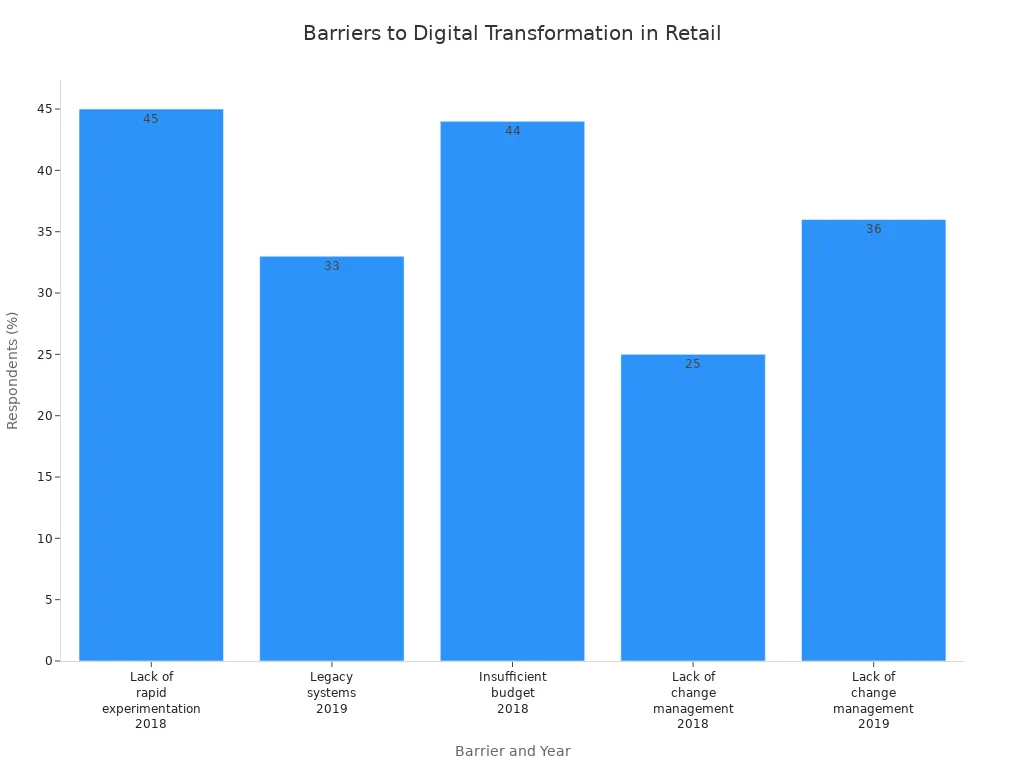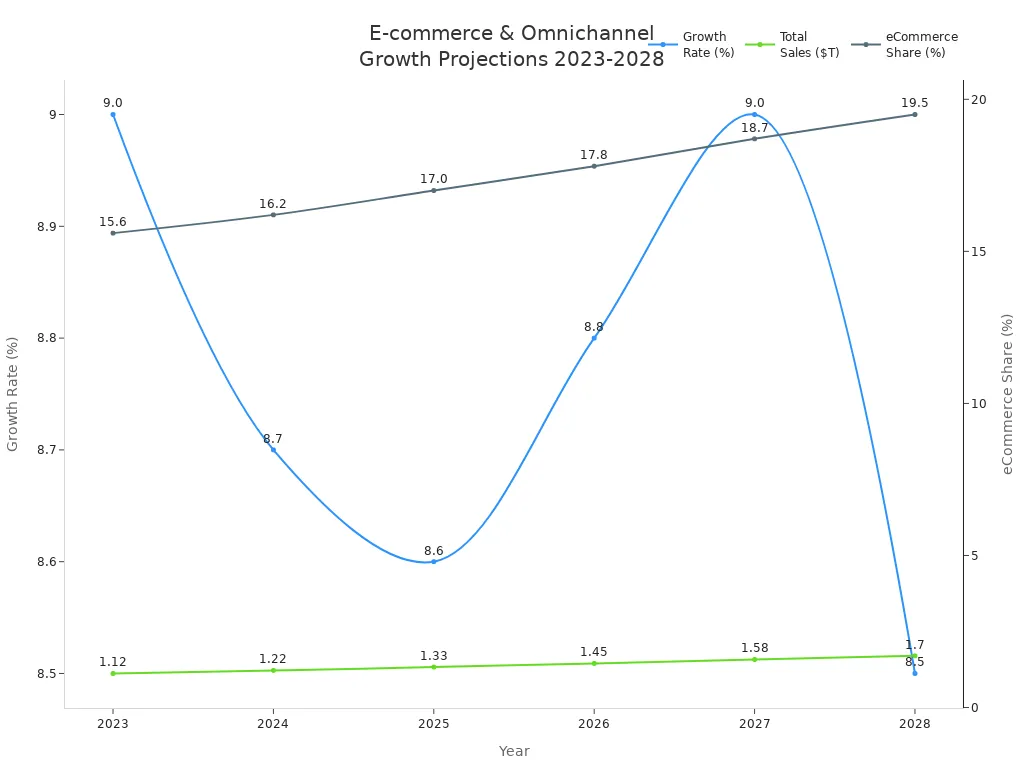Retail Store Operations in Today's Digital Retail Environment

You face a fast-changing retail world. Digital sales keep growing.
In 2025, 19.1% of global retail sales will happen online.
E-commerce could reach almost a quarter of all sales by 2027.
Retail Store Operations must adapt to new challenges. Many stores use old systems. Data security matters more than ever. Teams need to accept change. Budget limits and staff training can slow progress. When you see digital change as a chance to improve, you set your store up for success.
Key Takeaways
Embrace digital transformation to improve store operations. Use new technology to enhance efficiency and customer service.
Focus on building a flexible team. Invest in staff training to adapt to new systems and meet changing consumer expectations.
Utilize data analytics for better decision-making. Real-time insights help you manage inventory and personalize customer experiences.
Implement omnichannel solutions. Create a seamless shopping experience across online and in-store platforms to meet customer demands.
Stay proactive in addressing challenges. Monitor trends, adjust strategies, and keep innovating to stay competitive in the retail market.
Retail Store Operations Today

Key Challenges
You face many challenges in retail today. Stores must deal with rising costs. Inflation increases the price of goods, logistics, and labor. Many stores struggle to hire and keep enough staff. Understaffing can hurt customer service and make daily tasks harder. Labor shortages also push wages higher, which affects your budget.
Retail crime is another big problem. Losses from theft and inventory shrink have grown by 25% over the past year. This can cut into your profits and make it harder to keep shelves stocked. You must also manage the cost of training new employees. When staff leave, you spend more time and money to train replacements.
Tip: Focus on building a flexible team and use technology to track inventory. This can help you reduce losses and improve service.
Retail Store Operations now require you to balance these pressures while still delivering a great experience for your customers.
Changing Consumer Expectations
Your customers expect more from stores than ever before. They want shopping to feel easy, fast, and personal. Many shoppers now look for seamless experiences that connect online and in-store shopping. For example, Buy Online, Pick Up In Store (BOPIS) has become very popular.
Customers also want instant results. Fast shipping and real-time inventory updates are now the norm. People expect you to offer digital engagement, like mobile apps or digital kiosks, to make shopping smoother.
Shoppers care about sustainability and social responsibility. They want to know that your store supports good causes and uses eco-friendly practices. Personalization matters, too. Customers like it when you remember their preferences and offer tailored deals, but they also want you to respect their privacy.
Retail Store Operations must evolve to meet these new demands. You need to create a unique in-person experience, use digital tools, and make sure your staff can offer expert help. Larger stores now host events or offer personal shopping services to attract visitors and stand out from online-only shops.
Digital Transformation

Definition
Digital transformation means you bring digital business models into your store’s daily work. You use new technology to improve how your store runs. This change helps you create smooth experiences for both your team and your customers. You replace old systems with flexible, data-driven tools. These tools help you work faster and serve shoppers better.
You do not just add new gadgets. You change how your store thinks and acts. You use digital tools to solve problems and meet new needs. You focus on both the front of your store and the systems behind the scenes. This process lets you keep up with the market and stay ahead of your competition.
Note: 84% of retail leaders say digital transformation is crucial for their store’s survival in the next five years.
Core Elements
You need several key parts to build a strong digital transformation plan:
Technology Integration: Add smart tools like artificial intelligence (AI), machine learning, and the Internet of Things (IoT) to your store.
Omnichannel Presence: Give your customers a smooth shopping experience in-store, online, and on mobile.
Data Analytics: Use big data to learn about your customers and manage your inventory.
Automation: Let AI handle tasks like tracking stock or answering customer questions.
Mobile Integration: Offer apps that let people shop and pay with their phones.
Supply Chain Management: Use real-time data to make your supply chain faster and more reliable.
Customer Experience Enhancement: Personalize your service with digital tools.
Agile Operations: Stay flexible so you can react quickly to changes in the market.
You may face some barriers as you start this journey. Many stores struggle with old systems, tight budgets, and slow change. The table below shows the most common barriers to digital transformation in stores:
Barrier | Percentage of Respondents | Year |
|---|---|---|
Lack of rapid experimentation | 45% | 2018 |
Legacy systems | 33% | 2019 |
Insufficient budget | 44% | 2018 |
Lack of change management | 25% | 2018 |
Lack of change management | 36% | 2019 |

You can overcome these barriers by planning well and staying open to new ideas. Digital transformation helps you make Retail Store Operations more efficient and ready for the future.
Benefits of Digitization
Efficiency Gains
Digitization helps you run your store more smoothly. You can use digital tools to track inventory in real time. This reduces the risk of having too much or too little stock. Automation lets you handle routine tasks faster and with fewer mistakes. Your team can focus on helping customers and solving bigger problems.
Enhanced inventory management keeps shelves stocked and avoids waste.
Automation frees up staff for important work.
Real-time data helps you adjust prices and marketing quickly.
With these changes, you save time and money. You make your store more efficient and ready for growth.
Tip: Use digital systems to monitor inventory and automate daily tasks. This will help you avoid errors and improve your store’s performance.
Customer Experience
Digital tools make shopping easier and more personal for your customers. You can connect online and in-store experiences, so shoppers get what they want, when they want it. Fast service and accurate information build trust.
Strategy | Impact on Customer Experience |
|---|---|
Right product at the right moment | Customers find what they need quickly |
Fast service query resolution | Problems get solved without delay |
Online expectations matched in store | Shoppers enjoy a seamless experience |
Connected feedback and performance | Stores improve based on real customer input |
When you link customer feedback to business results, you create experiences that people love. This also helps your store stand out in a crowded market.
Better Decision-Making
Access to real-time data gives you the power to make smart choices. You can see what customers want and change your plans right away. This helps you set prices, manage inventory, and respond to trends.
Personalize offers based on what shoppers do now.
Adjust prices and stock to match demand.
React quickly to market changes and avoid problems.
Real-time analytics give you instant insights.
You can act fast to stay ahead of competitors.
Quick decisions help you plan better and grow your business.
Retail Store Operations become more agile and effective when you use data to guide your actions. You build a store that adapts and succeeds in a digital world.
Retail Technologies
Smart Retail Store Operations
You see new technology changing how stores work every day. Many stores now use smart tools to make jobs easier and improve the shopping experience. For example, some boutiques use AR mirrors that show you how clothes look and suggest matching items. Sam’s Club uses robots to clean floors and check shelves. These robots help staff spend more time with customers. Macy’s uses RFID tags to track inventory, so you always find what you need.
Example | Technology Used | Impact |
|---|---|---|
AR Mirrors in Boutiques | AR operated mirrors for style suggestions | Personalized shopping and better customer experience |
Sam’s Club Robotics | Robotic floor scrubbers and shelf analysts | More time for staff to help customers, better efficiency |
Amazon Go | AI vision and sensors for checkout-free shopping | No lines, faster shopping |
Macy’s | RFID tags for inventory tracking | Improved stock visibility and security |
GetGo | Digital smart screens in cooler aisles | More product info and higher sales |
Tip: Use digital displays and kiosks to give shoppers quick access to information and deals.
AI and Analytics
AI and analytics now play a big role in Retail Store Operations. You can use AI to manage inventory, set prices, and learn what customers like. For example, AI looks at past sales to help you avoid running out of stock or having too much. Predictive analytics helps you set prices that match the market. AI also finds patterns in customer data, so you can offer deals that fit their needs.
Application | Description |
|---|---|
Inventory Management | AI predicts what to stock and when, so you avoid shortages or waste. |
Dynamic Pricing | Analytics help you set prices based on demand and competition. |
Customer Insights | AI studies shopping habits to create personal offers. |
Fraud Detection | Analytics spot unusual activity to stop fraud. |
Supply Chain Optimization | Data helps you move products faster and cut costs. |
More than half of retail tasks can be automated with today’s technology.
77% of shoppers prefer brands that offer personal service.
Omnichannel Solutions
You need to connect your store, website, and mobile app to give shoppers a smooth experience. Omnichannel solutions help you do this. A unified system lets you sell, engage, and fulfill orders across all channels. Advanced point-of-sale systems work in every store format and handle many types of payments. Order management software shows you all your inventory and tracks every order.
Feature | Description |
|---|---|
Unified Approach | One app for selling, engagement, and order fulfillment across channels. |
Advanced POS | Handles all transactions in any store format. |
Order Management | Gives you a clear view of inventory and order status. |
Customer Engagement | Tools to connect with shoppers on every platform. |
Flexible Fulfillment | Options like BOPIS and curbside pickup for customer convenience. |
You see e-commerce and omnichannel sales growing every year. The chart below shows how online sales keep rising and will reach almost 20% of all retail by 2028.

Retail Store Operations that use these technologies can serve customers better and stay ahead in a fast-changing market.
Roadmap for Retailers
Assess and Plan
You should start by setting clear digital goals for your store. Pinpoint what you want to achieve with digital tools. Use frameworks like the Digital Maturity Model to check your current progress. This helps you see your strengths and where you need to improve. Next, create a digital roadmap. This plan should include your goals, the steps you will take, the resources you need, and a timeline for each step.
Define your digital objectives and set clear metrics.
Assess your digital maturity using proven frameworks.
Build a strategic plan with clear actions and deadlines.
Begin to put your plan into action using agile methods.
A strong business strategy guides your digital journey and keeps your team focused.
Build Digital Skills
Your team needs new skills to succeed in a digital world. Focus on training staff in digital point-of-sale systems, online inventory management, and digital marketing. Teach them how to engage customers on social media and use data analytics to track what shoppers like. Offer online courses that fit around work schedules. Make sure training covers mobile payment systems and how to help customers across different channels. Encourage your staff to learn how to solve technical problems for shoppers.
Proficiency in digital POS systems
Online inventory management
Social media engagement
Digital marketing
Data analytics
Tip: Digital retail learning helps your team grow and keeps your store competitive.
Implement Technologies
You can improve Retail Store Operations by using the right technology. Review your sales and inventory data often. Use AI to personalize the shopping experience and connect your store with online channels. Adopt cloud-based tools to save money and scale up as you grow. Make sure your systems work together smoothly. Protect customer data with strong security measures. Train your staff so they feel confident using new tools.
Strategy | Description |
|---|---|
Seamless Integration | Connect new tools with old systems for smooth transitions. |
Cost-Efficient Solutions | Use cloud-based tools to lower costs and grow easily. |
Data Security and Compliance | Keep customer data safe and follow privacy rules. |
Customer Engagement Enhancements | Use AI to make shopping more personal and keep customers coming back. |
Change Management | Train staff to use new technology and support them during changes. |
Measure and Adapt
Track your progress with clear metrics. Measure customer satisfaction, digital engagement, and how well your team uses new tools. Watch for faster processes and new revenue streams. Use business intelligence platforms and custom dashboards to see real-time results. Collect feedback from both customers and employees. Adjust your plan as you learn what works best.
Customer satisfaction scores and digital engagement
Process cycle times and automation rates
Revenue growth and cost savings
Employee productivity and digital skills
Real-time dashboards for tracking progress
Stay flexible. Use what you learn to keep improving your digital strategy.
To start your digital journey, follow these steps:
Assess your current business and gather feedback.
Set clear goals that match your strategy.
Build a roadmap with priorities and timelines.
Put new tools in place and connect them to your daily work.
Track progress and adjust as you learn.
Why keep innovating? | Benefit |
|---|---|
Meet new customer needs | Stay ahead of trends |
Boost efficiency | Save time and money |
Outperform competitors |
Retail Store Operations thrive when you act now. Take the next step and lead your team into a digital future.
FAQ
What is digital transformation in retail stores?
Digital transformation means you use new technology to improve your store. You replace old systems with smart tools. This helps you serve customers better and work faster.
How can you train your staff for digital tools?
You can offer online courses and hands-on workshops. Teach your team how to use digital point-of-sale systems and mobile apps. Encourage learning with short lessons and practice sessions.
Which technology helps you track inventory in real time?
RFID tags and cloud-based inventory software help you see stock levels instantly. These tools show what you have and what you need to order. You avoid running out of products.
Why does customer data matter in retail operations?
Customer data helps you understand shopping habits. You use this information to personalize offers and improve service. Data also helps you spot trends and make better business decisions.
See Also
The Future of Retail Lies in AI-Driven Stores
Transforming Online Retail Management with AI Tools
Smart Technology in Vending Machines Is Changing Retail
